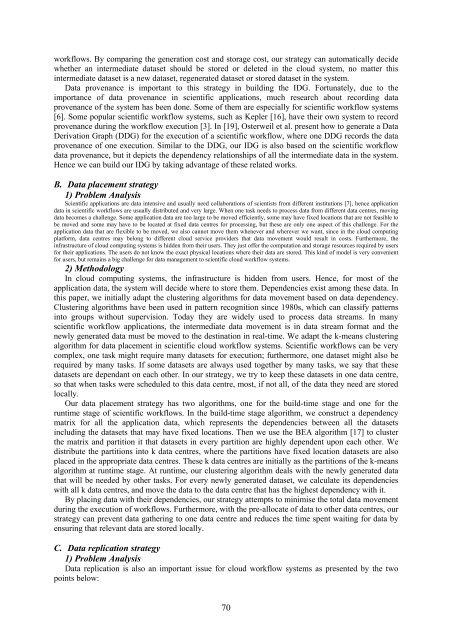Workshop proceeding - final.pdf - Faculty of Information and ...
Workshop proceeding - final.pdf - Faculty of Information and ...
Workshop proceeding - final.pdf - Faculty of Information and ...
Create successful ePaper yourself
Turn your PDF publications into a flip-book with our unique Google optimized e-Paper software.
workflows. By comparing the generation cost <strong>and</strong> storage cost, our strategy can automatically decide<br />
whether an intermediate dataset should be stored or deleted in the cloud system, no matter this<br />
intermediate dataset is a new dataset, regenerated dataset or stored dataset in the system.<br />
Data provenance is important to this strategy in building the IDG. Fortunately, due to the<br />
importance <strong>of</strong> data provenance in scientific applications, much research about recording data<br />
provenance <strong>of</strong> the system has been done. Some <strong>of</strong> them are especially for scientific workflow systems<br />
[6]. Some popular scientific workflow systems, such as Kepler [16], have their own system to record<br />
provenance during the workflow execution [3]. In [19], Osterweil et al. present how to generate a Data<br />
Derivation Graph (DDG) for the execution <strong>of</strong> a scientific workflow, where one DDG records the data<br />
provenance <strong>of</strong> one execution. Similar to the DDG, our IDG is also based on the scientific workflow<br />
data provenance, but it depicts the dependency relationships <strong>of</strong> all the intermediate data in the system.<br />
Hence we can build our IDG by taking advantage <strong>of</strong> these related works.<br />
B. Data placement strategy<br />
1) Problem Analysis<br />
Scientific applications are data intensive <strong>and</strong> usually need collaborations <strong>of</strong> scientists from different institutions [7], hence application<br />
data in scientific workflows are usually distributed <strong>and</strong> very large. When one task needs to process data from different data centres, moving<br />
data becomes a challenge. Some application data are too large to be moved efficiently, some may have fixed locations that are not feasible to<br />
be moved <strong>and</strong> some may have to be located at fixed data centres for processing, but these are only one aspect <strong>of</strong> this challenge. For the<br />
application data that are flexible to be moved, we also cannot move them whenever <strong>and</strong> wherever we want, since in the cloud computing<br />
platform, data centres may belong to different cloud service providers that data movement would result in costs. Furthermore, the<br />
infrastructure <strong>of</strong> cloud computing systems is hidden from their users. They just <strong>of</strong>fer the computation <strong>and</strong> storage resources required by users<br />
for their applications. The users do not know the exact physical locations where their data are stored. This kind <strong>of</strong> model is very convenient<br />
for users, but remains a big challenge for data management to scientific cloud workflow systems.<br />
2) Methodology<br />
In cloud computing systems, the infrastructure is hidden from users. Hence, for most <strong>of</strong> the<br />
application data, the system will decide where to store them. Dependencies exist among these data. In<br />
this paper, we initially adapt the clustering algorithms for data movement based on data dependency.<br />
Clustering algorithms have been used in pattern recognition since 1980s, which can classify patterns<br />
into groups without supervision. Today they are widely used to process data streams. In many<br />
scientific workflow applications, the intermediate data movement is in data stream format <strong>and</strong> the<br />
newly generated data must be moved to the destination in real-time. We adapt the k-means clustering<br />
algorithm for data placement in scientific cloud workflow systems. Scientific workflows can be very<br />
complex, one task might require many datasets for execution; furthermore, one dataset might also be<br />
required by many tasks. If some datasets are always used together by many tasks, we say that these<br />
datasets are dependant on each other. In our strategy, we try to keep these datasets in one data centre,<br />
so that when tasks were scheduled to this data centre, most, if not all, <strong>of</strong> the data they need are stored<br />
locally.<br />
Our data placement strategy has two algorithms, one for the build-time stage <strong>and</strong> one for the<br />
runtime stage <strong>of</strong> scientific workflows. In the build-time stage algorithm, we construct a dependency<br />
matrix for all the application data, which represents the dependencies between all the datasets<br />
including the datasets that may have fixed locations. Then we use the BEA algorithm [17] to cluster<br />
the matrix <strong>and</strong> partition it that datasets in every partition are highly dependent upon each other. We<br />
distribute the partitions into k data centres, where the partitions have fixed location datasets are also<br />
placed in the appropriate data centres. These k data centres are initially as the partitions <strong>of</strong> the k-means<br />
algorithm at runtime stage. At runtime, our clustering algorithm deals with the newly generated data<br />
that will be needed by other tasks. For every newly generated dataset, we calculate its dependencies<br />
with all k data centres, <strong>and</strong> move the data to the data centre that has the highest dependency with it.<br />
By placing data with their dependencies, our strategy attempts to minimise the total data movement<br />
during the execution <strong>of</strong> workflows. Furthermore, with the pre-allocate <strong>of</strong> data to other data centres, our<br />
strategy can prevent data gathering to one data centre <strong>and</strong> reduces the time spent waiting for data by<br />
ensuring that relevant data are stored locally.<br />
C. Data replication strategy<br />
1) Problem Analysis<br />
Data replication is also an important issue for cloud workflow systems as presented by the two<br />
points below:<br />
70
















